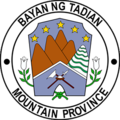Tadian | |
|---|---|
| Municipality of Tadian, Municipality of Kayan, Municipal District of Kayan | |
 | |
 Map of Mountain Province with Tadian highlighted | |
Location within the Philippines | |
| Coordinates: 16°59′46″N120°49′15″E / 16.9961°N 120.8208°E | |
| Country | Philippines |
| Region | Cordillera Administrative Region |
| Province | Mountain Province |
| District | Lone district |
| Barangays | 19 (see Barangays) |
| Government | |
| • Type | Sangguniang Bayan |
| • Mayor | Constito S. Masweng |
| • Vice Mayor | Alfonso D. Polan |
| • Representative | Maximo Y. Dalog Jr. |
| • Electorate | 12,340 voters (2025) |
| Area | |
• Total | 145.20 km2 (56.06 sq mi) |
| Elevation | 1,142 m (3,747 ft) |
| Highest elevation | 1,932 m (6,339 ft) |
| Lowest elevation | 550 m (1,800 ft) |
| Population (2024 census) [3] | |
• Total | 18,073 |
| • Density | 124.47/km2 (322.38/sq mi) |
| • Households | 4,484 |
| Economy | |
| • Income class | 4th municipal income class |
| • Poverty incidence | 7.91 |
| • Revenue | ₱ 154 million (2022) |
| • Assets | ₱ 387.2 million (2022) |
| • Expenditure | ₱ 116.9 million (2022) |
| • Liabilities | ₱ 83.79 million (2022) |
| Service provider | |
| • Electricity | Mountain Province Electric Cooperative (MOPRECO) |
| Time zone | UTC+8 (PST) |
| ZIP code | 2620 |
| PSGC | |
| IDD : area code | +63 (0)74 |
| Native languages | Kankanaey language Balangao Bontoc Ilocano Tagalog |
| Website | tadian |
Tadian, officially the Municipality of Tadian is a municipality in the province of Mountain Province, Philippines. According to the 2024 census, it has a population of 18,073 people. [5]



